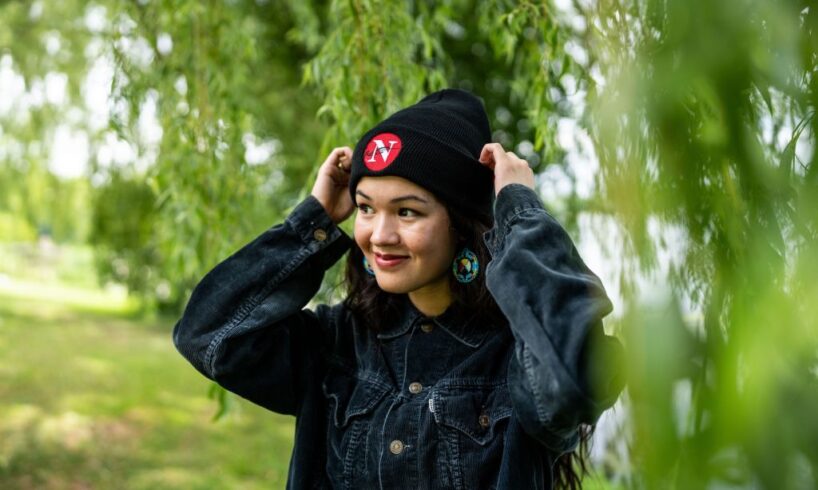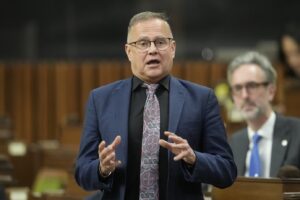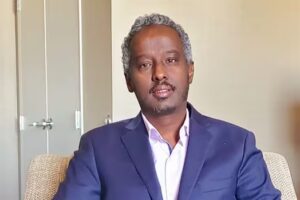
When Savannah Ridley and I first crossed paths — thanks to Shared Bylines, which pairs industry mentors with student journalists who are Black, Indigenous or people of colour — I thought, wow, she is going places. She was already a CJF-CBC Indigenous journalism fellow (a joint project of the national broadcaster and the Canadian Journalism Foundation). There, she was learning the ropes at CBC Montreal while also writing a complex, moving feature story about Sixties Scoop survivors impacted by Indigenous identity fraud — all while completing her studies in the journalism program at Toronto Metropolitan University and working as a fitness instructor in Toronto.
It was, to be honest, a little intimidating as a mentor to be paired up with someone who was already so accomplished. I felt like I was getting the better end of the bargain, particularly when Savannah accepted an assignment to fly up to Timmins, Ont., and report on the concerns of Indigenous folks in Treaty 9 as Doug Ford’s Bill 5 loomed. And when we opened applications this spring for our Indigenous editorial fellowship, a new role aimed at developing capacity in the Canadian journalism industry for editing Indigenous stories with care and attention, we were thrilled when Savannah applied. Among a pool of exceptional, brilliant candidates, she stood out with her passion for the industry and for reporting Indigenous stories. She might even renew your faith in media — or at least your hope for its future. Get to know her (and her perfect dog, Chuck) below:
Tell us a bit about yourself! Where are you from?
It’s kinda hard to explain exactly where I’m from. I was born in Hamilton, but I’ve lived all over the place, from my dad’s hometown of Thunder Bay, Ont., to Calgary. The biggest chunk of my life and my formative years were spent as a Calgarian, so I’m basically an Albertan/Ontarian hybrid.
What drew you to journalism?
My grandma, Edna Gooder! She worked as a nurse for the majority of her life, but a workplace injury prompted a career change. With tenacity and bravery, she went back to school to study journalism in her 50s.
Shortly after graduation, she started working as a staff reporter and photojournalist for Turtle Island News. When I was around seven years old, my grandma brought me along to an Indigenous convention she was covering in Calgary. My grandma was a Sixties Scoop survivor so we didn’t really grow up immersed in our Seneca culture. The extent of Indigeneity revealed to me until that point was my grandma’s beaded corn keychain and our family’s annual trip to the rez to register with the nation. Needless to say, the visual buffet of flamboyant hues and feathers of the regalia and the circadian thunder of the drums hit me like a truck. This is who we are? This is who I could be? And my grandma is putting them in the newspaper?! The whole experience blew my little mind. Of course, I didn’t really know what journalism was at that time, but I knew that I wanted to do something in the same world as my grandmother.
A couple years later, my grandma would break her right femur stepping out of bed. It turns out the consistent knee pain she’d had my whole life, thought to be “arthritis” but that her family doctor refused to confirm with a test, was actually kidney cancer that had eaten so much bone matter that simply getting out of bed turned the thickest bone in the human body into a rotten twig.
Just five weeks after that horrific morning, she passed away. Someone dropped the ball at every stage of her care, expediting her death.
At that age, I didn’t know about racism in the healthcare system and how it affects so many Indigenous people like my grandma. All I knew was the people who were supposed to help her did the exact opposite and that made me unspeakably angry.
As I’ve grown up, that anger has not subsided, it’s just refined. I knew I wanted to do what my grandma did, but her passing showed me the kind of work that I’m meant to do. Despite my grandma being a journalist herself, no publication contacted by my family wanted to tell the story of how she was failed by a system that was supposed to protect her.
I want to tell those stories.
Alberta/Ontario hybrid Savannah Ridley first caught the journalism bug at an Indigenous convention in Calgary, where the regalia and drums hit her “like a truck.”
You’re in journalism school at Toronto Metropolitan University — what’s your favourite class or learning so far?
I’ve learned from so many fantastic instructors, including Sonya Fatah, Craig Silverman, Shari Okeke, Adam Nayman, Jill Dempsey and Gavin Adamson. But my absolute favourite classes have been literary journalism and arts and culture writing, both taught by the remarkable Carly Lewis.
Carly’s classes were the birthplace for my love of a perfectly placed five-dollar word. Carly introduced me to the poetic possibilities of factual reporting and thus my writing style is completely her fault. She’s a life-changing instructor — without her, I truly would not be where I am now.
Who or what inspires you as a storyteller?
Creative writing has always been a huge interest of mine since before I could even read or write. My parents have stories of my chubby little hands wrecking havoc on our family desktop, just filling pages and pages of a Word doc with gibberish.
As I’ve grown up, many people have nurtured my love for writing in various forms along the way: in middle school it was poetry (I was incredibly dramatic and needed somewhere to put it), in high school it was personal essays (so, so argumentative) and now literary journalism (a healthy blend of the two). Those people are constantly in the back of my mind whenever I write. I bring along the wisdom of all of the teachers and mentors I’ve had in my life, and pour them into all of my work.
My grandma showed me what was possible, and I’ve been lucky that others have shown me how to do it. I want to be that mentor or teacher to someone else one day.
What kinds of stories do you hope to tell in your career?
Above all, I want whatever I’m covering to have a positive, tangible impact for the people and communities affected. Sixty years from now (wistfully believing I can ever retire in whatever ring of technofeudalist hell we live in), I hope to look back on my work and know that I’ve done good things for people’s material circumstances.
You have a perfect dog, Charlie (a.k.a. Chuck). If he was a journalist, what would his beat be?
Hmmmm … Chuck would either be like a self-care, health and wellness, lifestyle reporter or the complete opposite doing like break-neck-speed hard news. He’s the most unchill chiller I’ve ever met. One minute he’ll be on his back in my arms letting me file his nails with an emery board and the next minute he’s upset that my neighbours have the nerve to garden in their own backyard.
Savannah’s dog, Charlie, goes by many nicknames — Chuck, Chucko, Charles, Mr. Sir — but when in doubt you can simply refer to him as a perfect boy. Photo: Supplied by Charlie
Last year, you were a CJF-CBC Indigenous Journalism Fellow. What was the best part of working at the CBC?
The first few days of my fellowship, every day on my walk up to the Radio-Canada building, I’d cry. I’d think of my grandma and I literally just couldn’t help it. I could feel her presence every morning on that walk up and it was a real benchmark moment of “I’m doing what I’m meant to.”
Being in a CBC building, you can’t help but feel like a teeny tiny little minnow in an ocean of great blue whales. It was a huge privilege to pick the brains of the CBC Indigenous team and to push myself to meet the standard of the national broadcaster. At the time, the only published byline I had was in my school’s paper (not that the Eyeopener doesn’t have rigid fact-checking and editorial standards, but you know what I mean), so it was super nerve-wracking to make that jump, but those nerves made my CBC bylines taste that much sweeter. I earned those.
Working at the CBC in Montreal also gave me the ultimate goal “quality of life” wise. I was able to walk to work with my meal-prepped lunch in tow, I lived right by the waterfront so Chuck and I got to stroll along the boardwalk every night, and the Crème St-Denis’ from La Beignerie were a measly 40-minute walk uphill from my apartment and yes it was worth it every weekend.
This industry is famously tough, as every aspiring (and current!) journalist hears constantly. What keeps you going?
I feel like there will always be space for journalists who truly care about the work they are doing. I’m constantly reminded that this industry is not something that you can actually mentally check out of at the end of the day. Your work is part of a broader mission to educate people, lifting up forgotten or ignored stories and calling out when the structures and institutions that are meant to serve us are not doing their jobs. Harm is always being done. There’s always a story to tell. It’s hard work, often mentally gruelling, but knowing all that sweat is in service of the community makes it worth it. I’m used to dogging it out in retail with folks cussing me out for not having their size and I did all that in service of the wallets of shareholders that I’ll never meet. So, I’ll take the spiritual strain of journalism any day — it’s infinitely more fulfilling.
As a fitness instructor, what’s on your pump-up playlist?
Boring answer, but it really does depend. I oscillate between stuff I use for coaching — divorced-dad rock, hyper-femme pop and rap and a mix of Latin and Afro house, all with high beats per minute — and the complete opposite with “manipulator music” both the masc and femme varieties.
Savannah has something positive to say about the Canada goose, which is the kind of unexpected and diverse perspective we love to see here at The Narwhal.
To borrow a question from The Moose Questionnaire: think of three iconic Canadian animals and choose one each to kiss, marry and kill.
Controversial, but I’d marry the Canada goose. I think they’re sick — like they don’t care about a single thing. They’re just waddling around with their buddies or their babies or both and they’re eating grass and you can stop your two-tonne killing machine and wait for them to cross the street. I don’t care — argue with the wall.
I’d kiss nature’s blue-collar divas, the beaver. They’re so uptight and they work so hard. They deserve a little smooch on their fuzzy little foreheads.
I’m cheating but I have to agree with Senator Paula Simons — I would absolutely delight in destroying the mosquito. Not only am I allergic to them, but they’re just the ••••ing worst. I think the spiders would forgive me. There’s more than enough flies for them.
What do you hope to take away from your time at The Narwhal?
Everything! I’m usually on the reporting end. This is my first time in a position on the editorial side so, really, everything is new to me. I think The Narwhal is one of the few publications that truly puts the work in to make sure they’re meeting Indigenous Peoples where they are and representing culture, language, history, etc. respectfully and accurately. That is not an easy thing to commit to in every single story, let alone with long-form pieces, but The Narwhal does and I’m incredibly lucky to be mentored by this team. My main goal is to absorb as much knowledge as possible so I can take what I’ve learned from this experience and apply it in all of my work — reporting, editorial or otherwise. I also hope to make a good impression so they hire me for realsies one day!




